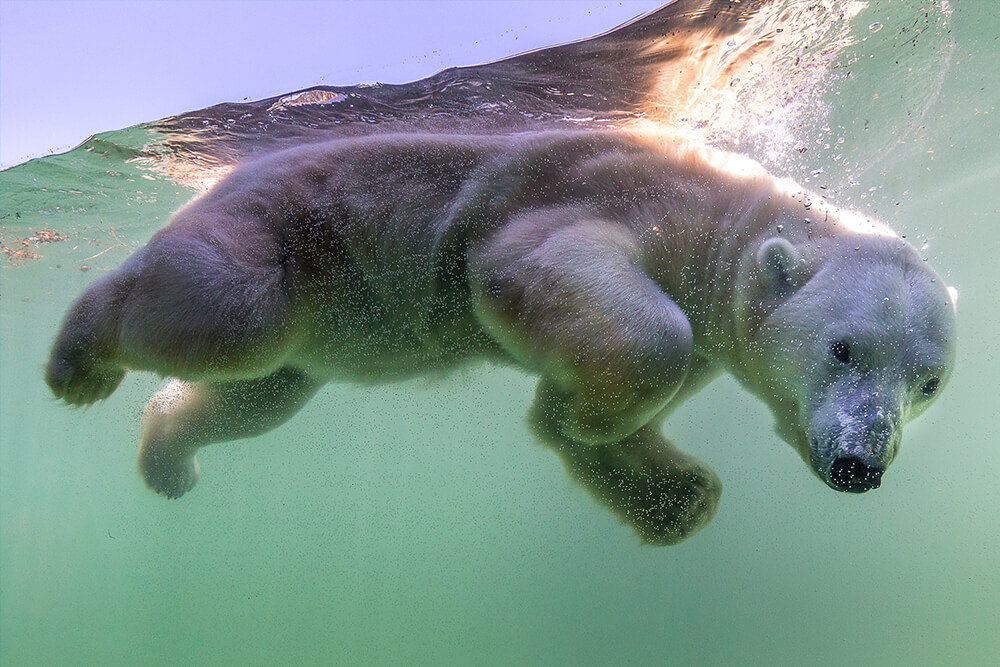How Do You Feed a Polar Bear in the Zoo

Polar bears live throughout the Arctic, in areas where they can hunt seals in wide cracks in the sea ice or at breathing holes. The taxonomic name for polar bears is Ursus maritimus, which means sea bear, a fitting name for these champion swimmers. They have been known to swim more than 60 miles (about 100 kilometers) without rest in search of food, using their broad front feet for paddling and their back legs like rudders to steer. Unfortunately, due to loss of ice, the bears are now having to swim longer distances, as much as a few hundred miles, which takes a toll on their energy and fat storage.
Despite the long, harsh winter, polar bears don't hibernate. In fact, most of them (except pregnant females) continue to hunt seals throughout the winter. When the weather is extremely cold, and hunting is impossible, bears may seek temporary shelter in snow dens until conditions improve.
A pregnant female stays in a snow den throughout her pregnancy, the birth of her cubs, and the first few months of the cubs' life, without leaving the den. Changes in her metabolism allow her to go without food, water, defecation, or urination for as long as eight months. For most mammals, fasting during pregnancy would be life threatening, but the female bear gains a massive amount of weight before she dens. Her stored fat reserves provide all the energy she needs to sustain herself and her cubs. Still, she wakes easily. This process is called winter sleep.
Polar bears have no natural enemies. Strong, ferocious, intelligent, and patient hunters, they top the food chain in the Arctic, where they dine primarily on seals. The bears can remain motionless for hours above a seal's breathing hole in the ice, just waiting for a seal to pop up. The polar bear's nose is so powerful it can smell a seal on the ice 20 miles (32 kilometers) away, sniff out a seal's den that has been covered with snow, and even find a seal's air hole in the ice up to 1 mile (1.6 kilometers) away. No wonder many people call them "noses with legs!"
Polar bears can see well underwater, spotting potential meals 15 feet (4.6 meters) away. They have a nictitating membrane, or third eyelid, that allows them to see underwater and protects their eyes in blowing snow.
Stiff fur on the sole of each foot keeps the bear from slipping on the ice. It also muffles the sound of the bear's approach when sneaking up on a sleeping seal. It costs a polar bear twice as much energy as most other mammals to move about in its Arctic environment. This helps explain their preference for resting frequently and hunting for seals using ambush techniques rather than stalking their prey.
The ringed seal is the polar bear's main prey, as it is the most numerous seal in the Arctic. One ringed seal provides a polar bear with enough energy for 11 days. Polar bears typically kill and eat every four to five days. These bears eat just about anything, if they have the opportunity, but it is important to remember that they need access to the high-calorie diet that seals provide. While they will eat walrus, caribou, beached whales, grass, and seaweed, none of these have been shown to provide adequate and reliable nutrition for polar bears.
Polar bears at the San Diego Zoo get a fortified meat-based commercial carnivore diet, dog kibble, trout and other fish, as well as root vegetables and lettuce as treats. Cow femur bones and thawed rabbits are added once or twice per week. Polar bears get very little nutrition or calories from vegetables, so these items are offered as treats, and the whole carrots keep their teeth clean.
Source: https://animals.sandiegozoo.org/animals/polar-bear#:~:text=Polar%20bears%20at%20the%20San,once%20or%20twice%20per%20week.
0 Response to "How Do You Feed a Polar Bear in the Zoo"
Post a Comment